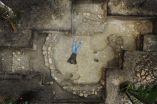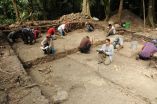(Press-News.org) Archaeologists working in Guatemala have unearthed new information about the Maya civilization's transition from a mobile, hunter-gatherer lifestyle to a sedentary way of life.
Led by University of Arizona archaeologists Takeshi Inomata and Daniela Triadan, the team's excavations of the ancient Maya lowlands site of Ceibal suggest that as the society transitioned from a heavy reliance on foraging to farming, mobile communities and settled groups co-existed and may have come together to collaborate on construction projects and participate in public ceremonies.
The findings, to be published this week in Proceedings of the National Academy of Sciences, challenge two common assumptions: that mobile and sedentary groups maintained separate communities, and that public buildings were constructed only after a society had fully put down roots.
"There has been the theory that sedentary and mobile groups co-exited in various parts of the world, but most people thought the sedentary and mobile communities were separate, even though they were in relatively close areas," said Inomata, a UA professor of anthropology and lead author of the PNAS study. "Our study presents the first relatively concrete evidence that mobile and sedentary people came together to build a ceremonial center."
A public plaza uncovered at Ceibal dates to about 950 B.C., with surrounding ceremonial buildings growing to monumental sizes by about 800 B.C. Yet, evidence of permanent residential dwellings in the area during that time is scarce. Most people were still living a traditional hunter-gatherer-like lifestyle, moving from place to place throughout the rainforest, as they would continue to do for five or six more centuries.
The area's few permanent residents could not have built the plaza alone, Inomata said.
"The construction of ceremonial buildings is pretty substantial, so there had to be more people working on that construction," he said.
Inomata and his colleagues theorize that groups with varying degrees of mobility came together to construct the buildings and to participate in public ceremonies over the next several hundred years. That process likely helped them to bond socially and eventually make the transition to a fully sedentary society.
"This tells us something about the importance of ritual and construction. People tend to think that you have a developed society and then building comes. I think in many cases it's the other way around," Inomata said.
"For those people living the traditional way of life, ceremony, ritual and construction became major forces for them to adapt a new way of life and build a new society. The process of gathering for ritual and gathering for construction helped bring together different people who were doing different things, and eventually that contributed to the later development of Mayan civilization."
The transition was gradual, with the Maya making the shift to a fully sedentary agrarian society, reliant on maize, by about 400 or 300 B.C., Inomata said.
"The most fascinating finding is that different peoples with diverse ways of life co-existed in apparent harmony for generations before establishing a more uniform society," said Melissa Burham, a study co-author and a graduate student in the UA School of Anthropology. "Discovering an ancient 'melting pot' is definitely the unexpected highlight of this research."
INFORMATION:
Other UA co-authors on the paper include Jessica MacLellan, an anthropology graduate student, and Jessica Munson, a recent UA graduate.
Inomata and his colleagues from the UA have been working for 10 years at Ceibal, along with collaborators from the United States, Canada, Guatemala and Japan. Their work is funded by the Alphawood Foundation; the National Geographic Society Committee for Research and Exploration; the National Endowment for the Humanities; the Ministry of Education, Culture, Sports, Science and Technology-Japan KAKENHI; and the Japan Society for the Promotion of Science KAKENHI.
Inomata is one of four chairs of the UA's Agnese Nelms Haury Program in Environment and Social Justice, which supports scientific and cultural studies rooted in the environment and social justice.
WINSTON-SALEM, N.C. - March 23, 2015 - The results of a blood test done immediately after heart surgery can be a meaningful indicator of postoperative stroke risk, a study by researchers at Wake Forest Baptist Medical Center has found.
An acutely elevated level of blood urea nitrogen (BUN) - a measure of kidney function detected through blood testing - was the most powerful predictor of postoperative stroke among the study's subjects.
Up to 9 percent of cardiac surgery patients suffer post-operative stroke, and these events are significantly more serious and more frequently ...
The concept was simple: If two compounds each individually show promise in preventing colon cancer, surely it's worth trying the two together to see if even greater impact is possible.
In this instance, Case Western Reserve cancer researcher Li Li, MD, PhD, could not have been more prescient.
Not only did the combination of the two improve outcomes in animal studies, but the dual-compound effect was dramatically better than either option alone. Even better, these impressive results required only modest amounts of metformin and Vitamin D3, making concerns about side ...
DURHAM, N.C. - Scientists have known for some time that people who carry a lot of weight around their bellies are more likely to develop diabetes and heart disease than those who have bigger hips and thighs. But what hasn't been clear is why fat accumulates in different places to produce these classic "apple" and "pear" shapes.
Now, researchers have discovered that a gene called Plexin D1 appears to control both where fat is stored and how fat cells are shaped, known factors in health and the risk of future disease.
Acting on a pattern that emerged in an earlier study ...
(MEMPHIS, Tenn. -- MARCH 23, 2015) Research led by scientists at St. Jude Children's Research Hospital has identified key molecules that trigger the immune system to launch an attack on the bacterium that causes tularemia. The research was published online March 16 in Nature Immunology.
The team, led by Thirumala-Devi Kanneganti, Ph.D., a member of the St. Jude Department of Immunology, found key receptors responsible for sensing DNA in cells infected by the tularemia-causing bacterium, Francisella. Tularemia is a highly infectious disease that kills more than 30 percent ...
MAYWOOD, Ill. - No cures are possible for most patients who suffer debilitating movement disorders called cerebellar ataxias.
But in a few of these disorders, patients can be effectively treated with regimens such as prescription drugs, high doses of vitamin E and gluten-free diets, according to a study in the journal Movement Disorders.
"Clinicians must become familiar with these disorders, because maximal therapeutic benefit is only possible when done early. These uncommon conditions represent a unique opportunity to treat incurable and progressive diseases," first ...
Contrary to the statistician's slogan, in the quantum world, certain kinds of correlations do imply causation.
Research from the Institute for Quantum Computing (IQC) at the University of Waterloo and the Perimeter Institute for Theoretical Physics shows that in quantum mechanics, certain kinds of observations will let you distinguish whether there is a common cause or a cause-effect relation between two variables. The same is not true in classical physics.
Explaining the observed correlations among a number of variables in terms of underlying causal mechanisms, known ...
A surgical sedative may hold the key to reversing the devastating symptoms of a neurodevelopmental disorder found almost exclusively in females. Ketamine, used primarily for operative procedures, has shown such promise in mouse models that Case Western Reserve and Cleveland Clinic researchers soon will launch a two-year clinical trial using low doses of the medication in up to 35 individuals with Rett Syndrome.
The $1.3 million grant from Rett Syndrome Research Trust (RSRT) represents a landmark step in area researchers' efforts to create a true regional collaborative ...
When an earthquake hits, the faster first responders can get to an impacted area, the more likely infrastructure--and lives--can be saved.
New research from the University of Iowa, along with the United States Geological Survey (USGS), shows that GPS and satellite data can be used in a real-time, coordinated effort to fully characterize a fault line within 24 hours of an earthquake, ensuring that aid is delivered faster and more accurately than ever before.
Earth and Environmental Sciences assistant professor William Barnhart used GPS and satellite measurements from ...
In addition to antiretroviral medications, people with HIV may soon begin receiving a home exercise plan from their doctors, according to a researcher at Case Western Reserve University's Frances Payne Bolton School of Nursing.
"People with HIV are developing secondary chronic illnesses earlier and more frequently than their non-HIV counterparts," said Allison Webel, PhD, RN, assistant professor of nursing. "And heart disease is one for which they are especially at risk."
An estimated 1.2 million people nationally live with HIV, according to the Centers for Disease ...
Today, ACS is launching its first open access multidisciplinary research journal. Aspiring to communicate the most novel and impactful science developments, ACS Central Science will feature peer-reviewed articles reporting on timely original research across chemistry and its allied sciences. Free to readers and authors alike, original research content will be accompanied by additional editorial features.
These additional editorial features include news stories contributed by the Society's award-winning science journalists, invited topical reviews (called Outlooks) from ...




